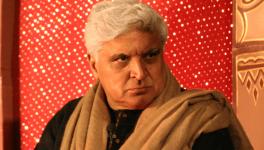BJP’s Top 3 Agenda for Bengal: Communalise, Polarise, Mobilise
Kolkata: “You know the rates by which the Rohingyas multiply. It’s eighty times higher than the rate of the Hindus,” said the middle-aged man while addressing a street corner meeting of the Bharatiya Janata Party (BJP) at Talpukur area on Baghajatin Station Road, a southern neighbourhood in Kolkata. It was December 20.
The man added: “The Mamata Banerjee government is welcoming the Rohingyas with open arms. They have spread all over West Bengal – the districts of Malda, Murshidabad, Uttar Dinajpur, North 24-Parganas and South 24-Parganas, Nadia and where not! This is a conspiracy to change West Bengal’s demography. And once the Muslims become the majority, the Hindus will be as much persecuted as the Hindus in Bangladesh.”
The man was Sandip Bagchi, a former president of the BJP’s Jadavpur north mandal. The street corner meeting was organised by Shakti Kendra, an organisational unit of the party. The content of his speech was not a case of aberration. This is one of the central themes in the speeches of BJP’s Bengal leaders, from state to district and block level.
On November 30, BJP’s state unit president Dilip Ghosh said: “A conspiracy has been hatched to turn West Bengal into West Bangladesh. Didimoni (Mamata Banerjee is commonly referred to as Didi) has turned all infiltrators into voters. Islamic terrorists are entering India through West Bengal and then spreading across the country. Lakhs of Hindus live here after being driven out of Bangladesh. Vote for the TMC if you (Hindus) want to be evicted once again.”
Earlier, the party’s Bengal in-charge, national general-secretary, Kailash Vijayvargiya, had said that the Mamata Banerjee government was ‘tees pratishat ki sarkar’, or a government for the 30%, an obvious reference to the state’s Muslim population, who made 27% of the state’s population in 2011.
Prime Minister Narendra Modi and Union Home Minister Amit Shah, too, have repeatedly accused Banerjee’s government of ‘politics of appeasement’.
Recently, responding to Banerjee’s allegations that people from other states were coming in to influence Bengal’s culture and politics, BJP state president Ghosh said the week before: “She identifies Modi-ji and Amit Shah as outsiders but the Rohingyas are her darlings.”
The BJP’s narrative around the Rohingyas sound exaggerated, if not untrue, as there was only one known settlement of Rohingya Muslims, who hail from Myanmar and are considered among the most-persecuted communities in the world, at Baruipur area in South 24-Parganas district
The settlement housed little more than a 100 Rohingyas, who had come not directly after crossing over through the Bangladesh border but after staying for months in Haryana and had picked up broken Hindi. However, they left for North India in mid-2019. Since the Rohingyas cannot speak Bengali, the main language of West Bengal, it is not easy for them to stay anywhere unnoticed.
Nevertheless, creating polarisation of Hindus against the alleged appeasement of Muslims is one among three of BJP’s top agenda for Bengal, the two others being polarising anti-incumbency against the state government in favour of BJP using central agencies and Union ministries; and mobilising the masses using the leadership resources of the national level.
In short, BJP’s Bengal agenda can be described as: communalise, polarise and mobilse.
The first in the list has been formally described by the Sangh Parivar leaders as ‘Hindu Jagran’, ‘speaking up for the cause of the Hindus’, ‘Hindu unity against Islamisation of Bengal’ and ‘attempt to protect the original culture, heritage and demography of West Bengal.’
Since 2017, ‘Jai Shri Ram’, a slogan associated with the Ram Temple movement, has emerged as one of the loudest political slogans in the state, as all speeches in all events of BJP and various organisations belonging to the Rashtriya Swayamsevak Sangh (RSS) family end with ‘Jai Shri Ram’.
A string of organisations are working for this project. These include the RSS and its affiliates, such as the Vishwa Hindu Parishad (VHP), Bajrang Dal, Hindu Jagran Manch (HJM), Ekal Abhiyan, Vanvasi Kalyan Ashram, Akhil Bharatiya Vidyarthi Parishad, Bharatiya Mazdoor Sangh and Akhil Bharatiya Rashtriya Shikshak Mahasangh.
The VHP, Bajrang Dal and HJM, for example, have been campaigning seeking ‘jihadi-mukto Bangla’, meaning a Bengal free from jihadi, or Islamic terrorist activities. This demand has been echoed by multiple state-level BJP leaders. The BMS, on the other hand, is campaigning among workers that Bangladeshi infiltrators are eating away local people’s jobs.
The BJP has made it clear that by infiltrator they mean only Muslims, while they considered migrants from other religions, including Hinduism, as refugees and victims of religious persecution in Bangladesh.
The BJP’s second agendum is to polarise anti-incumbency against the Trinamool Congress (TMC) government in its favour to corner the third party, a likely alliance between the Left parties and the Congress.
For this purpose, Central agencies will be used to ‘expose’ Banerjee’s administrative incapability and to create a perception that only BJP, having power at the Centre, is capable of taking on TMC. During April-May-June, the state government had repeated confrontations, with multiple Central ministries accusing the Mamata Banerjee government of being incompetent in handing the COVID-19 related crises.
Over the past few months, Central agencies, such as the National Investigation Agency (NIA), the Enforcement Directorate (ED) and the Central Bureau of Investigation (CBI) have intensified their activities in Bengal.
The NIA registered as many as six cases of suspected terrorist activities concerning West Bengal this year, compared with only one each in 2016, 2015, and 2014. This September, after the NIA arrested six suspected Al Qaeda operatives from Murshidabad, the district with India’s highest Muslim population, BJP’s Ghosh alleged that he had a hunch that the state government knowingly provides shelter to terrorists to reap political benefits.
The CBI, over the past two months, has intensified operations against cattle smugglers and coal mafias .
From August, the ED started sending notices to TMC leaders accused of being seen accepting cash in the Narada news sting operation that was published in 2016. The notices asked them to submit their income and asset details since 2008.
“If BJP were sincere about the Narada sting operation expose, it could have brought privilege motions in Parliament against the TMC MPs seen in the footage. But TMC and BJP have a secret understanding. Therefore, now the drama of sending notices ahead of the 2021 Assembly elections. All they want is to create a TMC versus BJP polarisation,” said Md Salim, a politburo member of the Communist Party of India (Marxist).
The CBI has also been probing the Narada scam and several senior TMC leaders, including MPs and state ministers, have submitted their voice samples before the CBI over the past two years.
The agencies are not alone. Only recently, the Ministry of Home Affairs (MHA) wanted to transfer three Indian Police Service (IPS) officers out of Bengal in an apparent message to all bureaucrats that the IPS and IAS (Indian Administrative Services) officers are finally under the Centre and should think twice before siding with the state administration against BJP’s interests.
The MHA had held these officers responsible for the security breach in the convoy of BJP national president Jagat Prakash Nadda during his visit to Diamond Harbour area when several vehicles in the convoy had come under attack from alleged TMC supporters.
The Mamata Banerjee government took a strong stand against letting its officers be transferred to the Centre and refused to abide by the order. This may well get dragged into court. Her government accused the Centre of disturbing India’s federal structure and received backing from Delhi Chief Minister Arvind Kejriwal, DMK chief M K Stalin and Chhattisgarh Chief Minister Bhupsh Baghel.
The third agendum is to mobilise senior BJP leaders from other states, including Uttar Pradesh, Madhya Pradesh, Gujarat and Maharashtra, involving state and Union ministers, to oversee election preparations in every district. These leaders have started visiting West Bengal.
Of them, Uttar Pradesh deputy chief minister Keshav Prasad Maurya has already paid visits to several districts of West Bengal besides Union ministers Arjun Munda, (ex-minister) Sanjeev Balyan, Gajendra Singh Shekhawat, Mansukh Mandaviya, Prahlad Singh Patel and Madhya Pradesh home minister Narottam Mishra, among others.
“These leaders have been given the responsibility of specific regions. Maurya will be focussing on the districts of Howrah and Hooghly, Mishra on East and West Burdwan, Munda on Purulia and Jhargram, and Balyan in North Bengal, for example,” said a BJP state unit leader who did not want to be identified.
“More leaders will be coming. Outside leaders of various ranks will be deputed for all of 294 Assembly seats,” the leader said.
According to BJP’s Ghosh, their main power is people’s support and the appeal of Modi and the organisational skills of Shah.
“What’s the TMC’s problem if our dedicated leaders and workers from other states come to assist the party? Is West Bengal not part of India? Moreover, the TMC is taking professional help from Prashant Kishor. Is he not an outsider?” Ghosh said.
TMC’s national spokesperson and Rajya Sabha MP Sukhendu Sekhar Roy, however, said BJP was trying to use Central agencies and involve leaders from outside states because they lacked organisational strength in West Bengal.
“They are trying to divide people on the basis of religion. Outsiders having no knowledge of Bengal’s culture and heritage have started camping in the state to create law and order problems so that BJP can later raise the demand for imposing President’s Rule. They are using Central agencies to intimidate our leaders and coax them to join BJP,” Roy said.
According to political analyst Udayan Bandyopadhyay, who teaches political science at Bangabasi College in Kolkata, the BJP is likely to gain from its Hindutva agenda in parts of North Bengal and the south-western parts of the state. He, however, felt that BJP may not reap as much benefit from Central agencies and the national leadership in 2021, as they did in the 2019 Lok Sabha elections.
“The BJP’s spectacular success in 2019 was largely due to a section of Left voters tactically shifting their votes to BJP. Prior to that, scores of Left supporters faced TMC’s atrocities, were implicated in numerous police cases and driven out of their localities. Even senior leaders like Amiya Patra and Niranjan Sihi were not spared. In contrast, BJP kept sending national-level leaders, guarded by central security forces, to stand by their workers. The situation prompted many Left supporters to think that BJP, by virtue of being in power at the Centre, could provide them shelter against TMC,” Bandyopadhyay said.
“However, now with the Left working hard, I am expecting the Left to get back a portion of its votes that went to BJP,” he added.
Biswanath Chakraborty, a professor of political science at Rabindra Bharati University in Kolkata, said among BJP’s biggest weapons is the party’s greater magnitude of human resources (national leadership) and financial resources than the TMC, backed by the appeal of PM Modi.
“However, to me, BJP’s biggest advantage is being a new and untested player in Bengal politics,” Chakraborty added.
The BJP has traditionally been a marginal force in the state and rose to prominence after Modi's ascent to power in Delhi. In the 2019 Lok Sabha elections, they won 18 of the state's 42 Lok Sabha seats, against 22 won by TMC.
The writer is a freelance journalist, author and researcher.
Get the latest reports & analysis with people's perspective on Protests, movements & deep analytical videos, discussions of the current affairs in your Telegram app. Subscribe to NewsClick's Telegram channel & get Real-Time updates on stories, as they get published on our website.
























